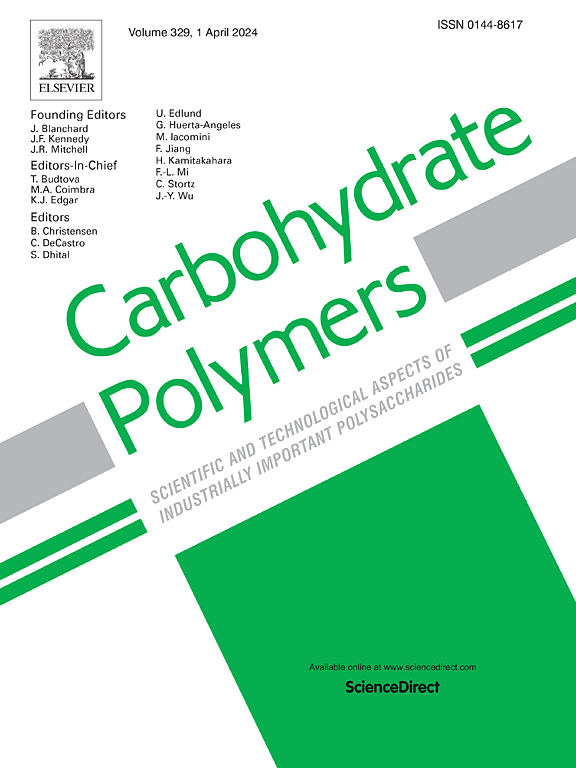Structural insights into polysaccharides in Ganoderma lucidum cell walls by solid-state NMR
IF 10.7
1区 化学
Q1 CHEMISTRY, APPLIED
引用次数: 0
Abstract
Ganoderma lucidum is a medicinal mushroom long esteemed in Asian traditional medicine for its health-promoting and longevity-enhancing properties. It contains over 400 bioactive compounds, among which its polysaccharides (GLPs) are especially significant due to their diverse biological functions. However, the molecular arrangement of GLPs within the cell-wall matrix remains poorly understood. To address this, we applied solid-state NMR for non-destructive structural characterization. Our analysis reveals a rigid core scaffold composed predominantly of β-1,3-glucan, chitin and chitosan, encased by a more mobile outer layer rich in β-1,4-glucan, α-1,3-glucans, α-1,4-glucan, arabinose, galactofuranose and α-mannose. Proton-driven spin-diffusion (PDSD) experiments identified 39 intermolecular contacts, especially between β-1,3-glucan and chitin, as well as among chitin chains. Within the core, chitosan displays nanosecond-to-microsecond mobility, suggesting a dynamically adaptable network. Hydration-kinetics measurements further distinguish these components, underscoring the hydrophilicity of β-1,3-glucan versus the hydrophobicity of chitin. Altogether, these findings support a model in which β-1,3-glucan–chitin interactions confer mechanical strength, while chitosan provides flexibility to enable adaptive cell-wall remodeling.
固态核磁共振对灵芝细胞壁中多糖的结构见解
灵芝(Ganoderma lucidum)是一种药用蘑菇,因其具有促进健康和延长寿命的特性而长期受到亚洲传统医学的推崇。它含有400多种生物活性化合物,其中多糖(GLPs)因其多种生物功能而尤为重要。然而,glp在细胞壁基质中的分子排列仍然知之甚少。为了解决这个问题,我们应用固态核磁共振进行非破坏性结构表征。我们的分析揭示了一个刚性的核心支架主要由β-1,3-葡聚糖、几丁质和壳聚糖组成,由富含β-1,4-葡聚糖、α-1,3-葡聚糖、α-1,4-葡聚糖、阿拉伯糖、半乳糖呋喃糖和α-甘露糖的更具流动性的外层包裹。质子驱动的自旋扩散(PDSD)实验确定了39个分子间的接触,特别是β-1,3-葡聚糖和几丁质之间以及几丁质链之间的接触。在核内,壳聚糖表现出纳秒到微秒的迁移性,表明这是一个动态适应的网络。水合动力学测量进一步区分了这些成分,强调了β-1,3-葡聚糖的亲水性和几丁质的疏水性。总之,这些发现支持一个模型,其中β-1,3-葡聚糖-几丁质相互作用赋予机械强度,而壳聚糖提供灵活性,使适应性细胞壁重塑。
本文章由计算机程序翻译,如有差异,请以英文原文为准。
求助全文
约1分钟内获得全文
求助全文
来源期刊

Carbohydrate Polymers
化学-高分子科学
CiteScore
22.40
自引率
8.00%
发文量
1286
审稿时长
47 days
期刊介绍:
Carbohydrate Polymers stands as a prominent journal in the glycoscience field, dedicated to exploring and harnessing the potential of polysaccharides with applications spanning bioenergy, bioplastics, biomaterials, biorefining, chemistry, drug delivery, food, health, nanotechnology, packaging, paper, pharmaceuticals, medicine, oil recovery, textiles, tissue engineering, wood, and various aspects of glycoscience.
The journal emphasizes the central role of well-characterized carbohydrate polymers, highlighting their significance as the primary focus rather than a peripheral topic. Each paper must prominently feature at least one named carbohydrate polymer, evident in both citation and title, with a commitment to innovative research that advances scientific knowledge.
 求助内容:
求助内容: 应助结果提醒方式:
应助结果提醒方式:


